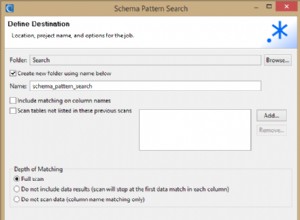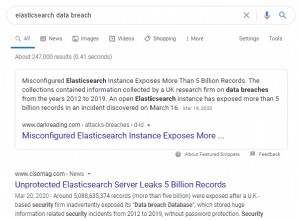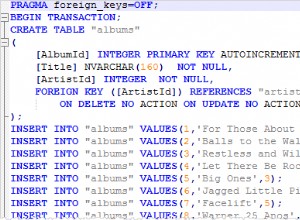Negromanzia:Per coloro che necessitano di un esempio funzionante:
DO $$
DECLARE myxml xml;
BEGIN
myxml := XMLPARSE(DOCUMENT convert_from(pg_read_binary_file('MyData.xml'), 'UTF8'));
DROP TABLE IF EXISTS mytable;
CREATE TEMP TABLE mytable AS
SELECT
(xpath('//ID/text()', x))[1]::text AS id
,(xpath('//Name/text()', x))[1]::text AS Name
,(xpath('//RFC/text()', x))[1]::text AS RFC
,(xpath('//Text/text()', x))[1]::text AS Text
,(xpath('//Desc/text()', x))[1]::text AS Desc
FROM unnest(xpath('//record', myxml)) x
;
END$$;
SELECT * FROM mytable;
O con meno rumore
SELECT
(xpath('//ID/text()', myTempTable.myXmlColumn))[1]::text AS id
,(xpath('//Name/text()', myTempTable.myXmlColumn))[1]::text AS Name
,(xpath('//RFC/text()', myTempTable.myXmlColumn))[1]::text AS RFC
,(xpath('//Text/text()', myTempTable.myXmlColumn))[1]::text AS Text
,(xpath('//Desc/text()', myTempTable.myXmlColumn))[1]::text AS Desc
,myTempTable.myXmlColumn as myXmlElement
FROM unnest(
xpath
( '//record'
,XMLPARSE(DOCUMENT convert_from(pg_read_binary_file('MyData.xml'), 'UTF8'))
)
) AS myTempTable(myXmlColumn)
;
Con questo file XML di esempio (MyData.xml):
<?xml version="1.0" encoding="UTF-8" standalone="yes"?>
<data-set>
<record>
<ID>1</ID>
<Name>A</Name>
<RFC>RFC 1035[1]</RFC>
<Text>Address record</Text>
<Desc>Returns a 32-bit IPv4 address, most commonly used to map hostnames to an IP address of the host, but it is also used for DNSBLs, storing subnet masks in RFC 1101, etc.</Desc>
</record>
<record>
<ID>2</ID>
<Name>NS</Name>
<RFC>RFC 1035[1]</RFC>
<Text>Name server record</Text>
<Desc>Delegates a DNS zone to use the given authoritative name servers</Desc>
</record>
</data-set>
Nota:
MyData.xml deve trovarsi nella directory PG_Data (la directory padre della directory pg_stat).
es. /var/lib/postgresql/9.3/main/MyData.xml
Ciò richiede PostGreSQL 9.1+
Nel complesso, puoi ottenerlo senza file, in questo modo:
SELECT
(xpath('//ID/text()', myTempTable.myXmlColumn))[1]::text AS id
,(xpath('//Name/text()', myTempTable.myXmlColumn))[1]::text AS Name
,(xpath('//RFC/text()', myTempTable.myXmlColumn))[1]::text AS RFC
,(xpath('//Text/text()', myTempTable.myXmlColumn))[1]::text AS Text
,(xpath('//Desc/text()', myTempTable.myXmlColumn))[1]::text AS Desc
,myTempTable.myXmlColumn as myXmlElement
-- Source: https://en.wikipedia.org/wiki/List_of_DNS_record_types
FROM unnest(xpath('//record',
CAST('<?xml version="1.0" encoding="UTF-8" standalone="yes"?>
<data-set>
<record>
<ID>1</ID>
<Name>A</Name>
<RFC>RFC 1035[1]</RFC>
<Text>Address record</Text>
<Desc>Returns a 32-bit IPv4 address, most commonly used to map hostnames to an IP address of the host, but it is also used for DNSBLs, storing subnet masks in RFC 1101, etc.</Desc>
</record>
<record>
<ID>2</ID>
<Name>NS</Name>
<RFC>RFC 1035[1]</RFC>
<Text>Name server record</Text>
<Desc>Delegates a DNS zone to use the given authoritative name servers</Desc>
</record>
</data-set>
' AS xml)
)) AS myTempTable(myXmlColumn)
;
Si noti che a differenza di MS-SQL, xpath text() restituisce NULL su un valore NULL e non una stringa vuota.
Se per qualsiasi motivo è necessario verificare esplicitamente l'esistenza di NULL, è possibile utilizzare [not(@xsi:nil="true")] , a cui devi passare un array di namespace, perché altrimenti ottieni un errore (tuttavia, puoi omettere tutti i namespace tranne xsi).
SELECT
(xpath('//xmlEncodeTest[1]/text()', myTempTable.myXmlColumn))[1]::text AS c1
,(
xpath('//xmlEncodeTest[1][not(@xsi:nil="true")]/text()', myTempTable.myXmlColumn
,
ARRAY[
-- ARRAY['xmlns','http://www.w3.org/1999/xhtml'], -- defaultns
ARRAY['xsi','http://www.w3.org/2001/XMLSchema-instance'],
ARRAY['xsd','http://www.w3.org/2001/XMLSchema'],
ARRAY['svg','http://www.w3.org/2000/svg'],
ARRAY['xsl','http://www.w3.org/1999/XSL/Transform']
]
)
)[1]::text AS c22
,(xpath('//nixda[1]/text()', myTempTable.myXmlColumn))[1]::text AS c2
--,myTempTable.myXmlColumn as myXmlElement
,xmlexists('//xmlEncodeTest[1]' PASSING BY REF myTempTable.myXmlColumn) AS c1e
,xmlexists('//nixda[1]' PASSING BY REF myTempTable.myXmlColumn) AS c2e
,xmlexists('//xmlEncodeTestAbc[1]' PASSING BY REF myTempTable.myXmlColumn) AS c1ea
FROM unnest(xpath('//row',
CAST('<?xml version="1.0" encoding="utf-8"?>
<table xmlns:xsi="http://www.w3.org/2001/XMLSchema-instance">
<row>
<xmlEncodeTest xsi:nil="true" />
<nixda>noob</nixda>
</row>
</table>
' AS xml)
)
) AS myTempTable(myXmlColumn)
;
Puoi anche controllare se un campo è contenuto in un testo XML, facendo
,xmlexists('//xmlEncodeTest[1]' PASSING BY REF myTempTable.myXmlColumn) AS c1e
ad esempio quando si passa un valore XML a una procedura/funzione memorizzata per CRUD.(vedi sopra)
Inoltre, nota che il modo corretto per passare un valore null in XML è <elementName xsi:nil="true" /> e non <elementName /> o niente. Non esiste un modo corretto per passare NULL negli attributi (puoi solo omettere l'attributo, ma diventa difficile/lento dedurre il numero di colonne e i loro nomi in un set di dati di grandi dimensioni).
per esempio.
<?xml version="1.0" encoding="UTF-8" standalone="yes"?>
<table>
<row column1="a" column2="3" />
<row column1="b" column2="4" column3="true" />
</table>
(è più compatto, ma pessimo se devi importarlo, specialmente se da file XML con più GB di dati - vedi un meraviglioso esempio di questo nel dump dei dati di StackOverflow)
SELECT
myTempTable.myXmlColumn
,(xpath('//@column1', myTempTable.myXmlColumn))[1]::text AS c1
,(xpath('//@column2', myTempTable.myXmlColumn))[1]::text AS c2
,(xpath('//@column3', myTempTable.myXmlColumn))[1]::text AS c3
,xmlexists('//@column3' PASSING BY REF myTempTable.myXmlColumn) AS c3e
,case when (xpath('//@column3', myTempTable.myXmlColumn))[1]::text is null then 1 else 0 end AS is_null
FROM unnest(xpath('//row', '<?xml version="1.0" encoding="UTF-8" standalone="yes"?>
<table>
<row column1="a" column2="3" />
<row column1="b" column2="4" column3="true" />
</table>'
)) AS myTempTable(myXmlColumn)




